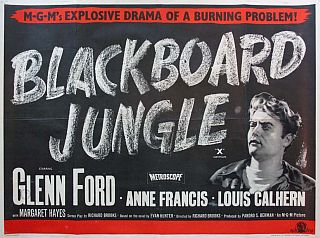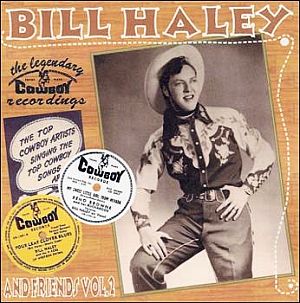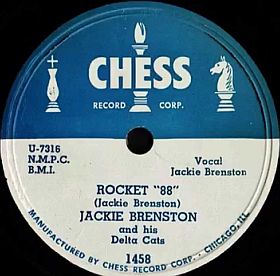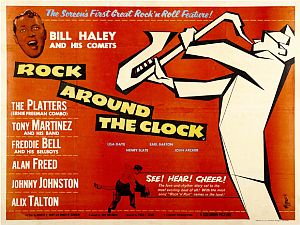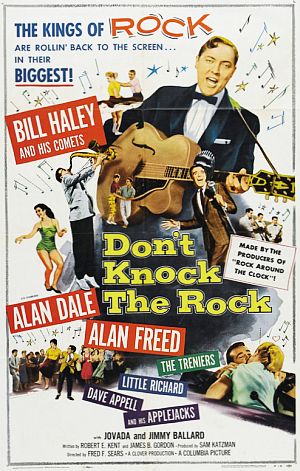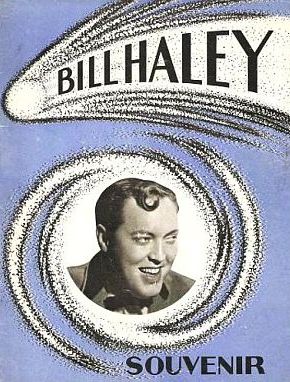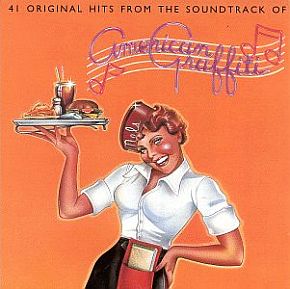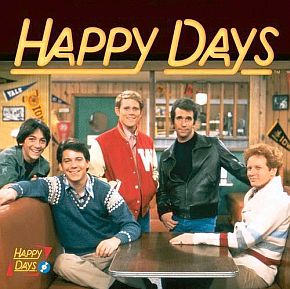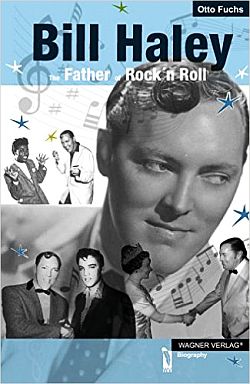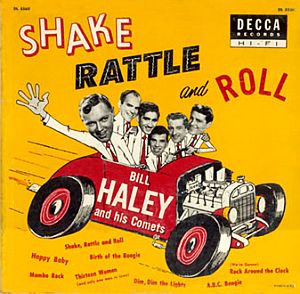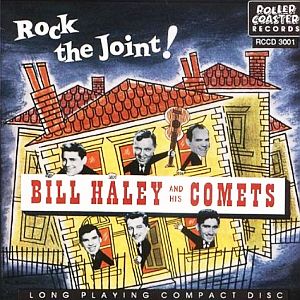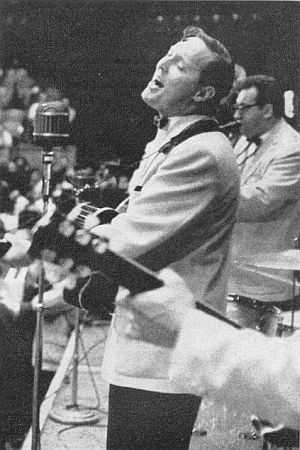
1950s: Bill Haley & some of his band performing.
“Rock Around the Clock” was also known by its somewhat longer title, “We’re Gonna‘ Rock Around The Clock.” It became one of the first American rock `n roll recordings to find major success and hit the top of the music charts, not only in America, but also around the world. In fact, the reception overseas at the time was quite strong and surprising. By today’s standards, of course, the song may seem unexceptional. Yet in its day it was a significant departure from the mostly staid fare of 1950s music, offering a sharp break with the status quo and setting popular music on a new course.
Although there were other songs at the time that were also part of the new, rising musical genre being called “rock `n roll” – including some by Fats Domino dating to 1950, Haley’s own “Crazy Man, Crazy” of 1953, and Big Joe Turner’s “Shake, Rattle and Roll” of 1954 – it would be Haley’s recording of “Rock Around the Clock” in 1954 that would become the break out tune for rock `n roll. In fact, “Rock Around The Clock” is widely considered the one song, more than any other, that brought rock `n roll into mainstream culture around the world. In its day, the song also became an anthem for mid-1950s youth. Yet when “Rock Around The Clock” was first released in May of 1954, it had modest success at best, and seemed headed for the rock `n roll dustbins.
Then, about a year later, in May of 1955, the song went to the top of the music charts after it was used as the opening music for the Metro-Goldwyn-Mayer movie, Blackboard Jungle, a story about a high school teacher’s confrontation with juvenile delinquents.
It was the first time rock ’n roll music would be used in film, presaging a lucrative business relationship between rock ‘n roll and film that would grow to great levels in the decades that followed. But in the mid-1950s this was totally new territory – and the kids ate it up.In fact, in some theaters where the film was shown, both in the U.S. and in Europe, there would be riots and near riots, as the kids would resort to dancing in the aisles when the song came on, while others resorted to more serious mischief coming out of theaters at some locations.
Rock musician and social critic Frank Zappa was among young teens who saw Blackboard Jungle in the spring of 1955 and was energized by the sound of “Rock Around the Clock,” as he would explain some years later: “I didn’t care if Bill Haley was white or sincere. He was playing the teenage National Anthem and it was loud. I was jumping up and down…. [Although the film] had the old people winning in the end, it represented an endorsement. ‘They have made a movie about us, therefore we exist’.”
And journalist Michael Hall, later writing a piece on Bill-Haley, describes his experience as a teenager hearing the same song nearly 20 years later in another film:
“…I’ve been a fan of [Haley] ever since I saw American Graffiti, in 1973, when I was fifteen. ‘Rock Around the Clock,’ the first song in the movie’s first scene, jumped out of the theater speakers: an exuberant 128 seconds of driving guitar and sax riffs, an amazing guitar solo, and Haley’s breathless vocal. It made me feel good; it made me want to move. And if it did that to me [in 1973], imagine what it did to teens in 1955. Kids—to say nothing of grown-ups—had never heard anything like it before….”
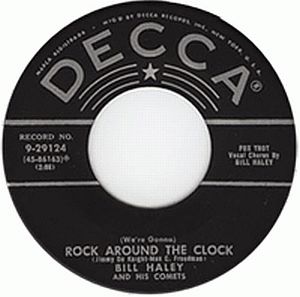
May 1954: Decca record label 45rpm version of “Rock Around the Clock,” by Bill Haley and His Comets. Click for digital.
Music Player
“Rock Around The Clock”
Still today, in the annals of music history, “Rock Around The Clock” has held it own. The song is ranked at No. 158 on the Rolling Stone magazine’s list of “The 500 Greatest Songs of All Time.” And in 2004, the American Film Institute ranked the song at No. 50 on its “100 Years…100 Songs” list of top tunes in American cinema. Turner Classic Movies also lists the Bill Haley/Blackboard Jungle soundtrack on its Top 15 Most Influential Movie Soundtracks of all time.
Bill Haley, in particular, was a bit of an inventor and synthesizer, taking from the music around him and creating something new. His early 1950s hits would prove to be something of a transition period from one musical era to the next. Michael Hall, writing a Texas Monthly piece on Bill Haley in 2011, noted: “…There’s a before ‘Rock Around the Clock’ and an after ‘Rock Around the Clock.’ The before is Glenn Miller, Perry Como, and Bing Crosby. The after is Elvis, the Beatles, and Lady Gaga.” Haley’s story provides some interesting rock `n roll history; it’s a story about changing music and changing culture – and also a story about how one person’s life unfurled in both good and troubling ways with the ebb and flow of rock `n roll popularity.
Country-to-R&B
William John Clifton “Bill” Haley, Jr. was born in Highland Park, Michigan on July 6, 1925. When he was four years old, during an operation on his ear, the vision in his left eye would become impaired when an optic nerve was accidentally severed. After that, Haley’s left eye was never quite right, looking off in an odd direction, contributing to a self-conscious shyness. Yet, one thing Bill Haley did have was a good ear for music. His father, from Firebrick, Kentucky, played banjo. His mother, an English emigree from Lancashire, had been classically trained and taught piano. The family later moved to the crossroads town of Booth’s Corner, Pennsylvania in the late 1940s, not far from Philadelphia. It was there that teenager Bill Haley began learning to play the guitar. He had idolized the singing cowboys of that era and dreamed of becoming a country and western singer. For a time, after he quit school, he tried his hand with a series of country and western bands. Then he came back to the Philadelphia area and did a stint as a radio disc jockey in Chester, Pennsylvania where he played a mix of tunes, including rhythm and blues (R & B) recordings, in those days sometimes called “race records.” Then he went back on the road with more country and western groups – among them, The Four Aces of Western Swing and Bill Haley and The Saddlemen. Haley and his bandmates also cut some country and western records.
But in 1951, Haley, prodded by the owner of Essex Records, began experimenting with a new sound. They cut a version of a song called “Rocket 88,” an R&B song written by black artist, Jackie Brenston ( and according to one account, although credited to “Jackie Brenston and his Delta Cats” on Chess Records, was actually performed by Ike Turner and Knights, later of Ike & Tina Turner fame). Haley’s version of “Rocket 88” in any case, on Essex Records, sold 10,000 copies, a modest result but enough to convince Haley that this new “high energy” sound – basically, black R& B music – would appeal to teenagers. ( In Cleveland, Ohio, meanwhile, a radio DJ named Alan Freed had come to the same conclusion about black R&B music, and by 1951 his on-air selections of these songs were becoming popular on his “Moondog Rock `n Roll Party” radio show).
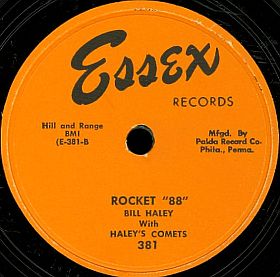 Bill Haley & Comets version of “Rocket 88" recorded on the Essex recording label, June 1951. |
Haley, by recording “Rocket 88,” was contributing to the founding rock `n roll, even if he didn’t know it at the time. This was the era before Dwight D. Eisenhower was even running for President. Elvis Presley was a 15 year-old tenth grader and the Beatles and Rolling Stones were still in grammar school. By 1952, Haley dropped the country and western style and re-named his group Bill Haley & His Comets. Their sound was unique at the time, coming out of a rockabilly mold, framed by slap-back bass, electric guitar, and pedal steel guitar. They also picked up on youth culture of their day by playing at high school dances for a time, with Haley especially attentive to the slang and talk of the kids.
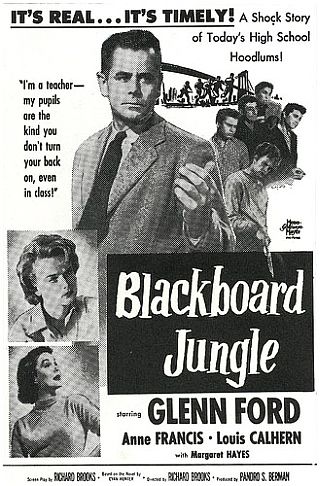
Film poster for “Blackboard Jungle,” the 1955 film starring Glenn Ford that featured “Rock Around The Clock” song. Click for DVD.
Next up for Haley, in the spring of 1954, was the first recording of “Rock Around the Clock,” now on the Decca record label. Then came “Shake, Rattle and Roll,” another successful black R&B tune by Big Joe Turner, an artist Haley admired. “Shake, Rattle and Roll” became a Top Ten hit for Haley, both in the U.S. and the U.K., selling a million copies by July 1954. But “Rock Around the Clock,” in its first release made earlier that year, had not done well.
In fact, “Rock Around The Clock” didn’t break big until the spring of 1955 after it was used in the soundtrack for the movie, Blackboard Jungle. The song, in somewhat altered version, is used four times in the film: during the film’s opening credits with a lengthy drum introduction, in the first scene, as an instrumental version in the middle of the film, and at the close of the movie. Given the wild reception the song received from the kids who saw the film, it wasn’t long before Haley and the Comets realized they had a giant hit on their hands, as Marshall Lytle, the original bass player for The Comets, recalled in one later interview:
“We were travelling on the New York Thruway from Buffalo to Boston to do a television show. I turned the radio on and ‘Rock Around The Clock’ was playing, [The car] was a new Cadillac that Bill had just bought. It had one of those Selectrix dials where you just push the bar and it goes to the next station. I pushed the bar and it was playing again on another radio station. I pushed the bar again and it was playing again. At one given moment, it was playing five times on the dial. Within five minutes, I must’ve heard it a dozen times. I said: ‘This is a monster hit.’ When you hear a song that many times on that many different radio stations, you know damn well that it was a monster hit.”
In March 1955 alone, “Rock Around The Clock” sold one million copies. Blackboard Jungle, meanwhile, continued to receive wide coverage in the press that summer, boosting Haley’s stock to the point that even Haley – then 30 years old – was thought of as a young rebel. “Rock Around The Clock” was steadily marching to the top of the Billboard chart; it would soon hit No. 1. Haley’s music was now getting much broader notice.
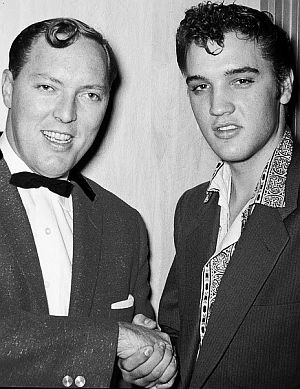
Oct 1955: Rock icons, Bill Haley and Elvis Presley, around the time of their first meeting.
Haley and the Comets were also appearing all over the country through 1955, sharing the bill sometimes with well known and up-and-coming artists. During a Midwest tour with Hank Snowden (poster below), Elvis Presley and Bill Haley first met at a Brooklyn High School show in Cleveland, Ohio. It was late October 1955. Presley was just starting out, doing regional shows mostly in the south. He had cut and released a few songs by this time with Sun Studios of Memphis, Tennessee, including “I Forgot To Remember To Forget” of August 1955 (w/“Mystery Train” on its B side), which would make him a nationally-known country music star after it hit No. 1 on the Country & Western chart in February 1956. Presley then was still about a year away from his rising rock `n roll stardom. But on the Snowden two-week tour in the fall of 1955, Elvis rode with Haley in his car between shows, and the two rock `n rollers got to know each other, sharing views on their music and hopes for the future.
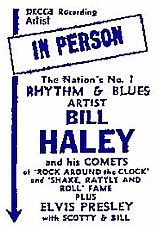 Portion of 1955 poster w/Elvis as minor act; click for similar. |
During 1955 and early 1956, Haley and the Comets were also busy turning out new top 40 hits. Among those released in the U.S., for example, were: “Dim, Dim The Lights” in January (No.10); “Birth Of The Boogie” in April (No.17); “Mambo Rock,” also in April (No.17); re-release of “Rock Around the Clock” in June (No.1); “Two Hound Dogs” in September (No.15); “Burn That Candle” in November (No.9); “Rock-A-Beatin’ Boogie” in November (No.23); and Top Ten hit, “See You Later, Alligator” in February 1956 (No.6). And by this time as well, the first in a series of the rock `n roll films would appear, titled Rock Around the Clock, starring Haley and his band.
At The Movies
Rock Around the Clock, produced by Columbia Pictures, was released in March 1956. It was followed by another not long thereafter, Don’t Knock the Rock, released in December that year, again starring Haley. These films were the first of what would later be called “the rock exploitation genre.” They all had a relatively simple formula: round up as many pop music stars as you could afford, and use a story line that showcased the music. In Rock Around the Clock, Haley’s hit song of that name is used at least three times, along with songs from a dozen or more other artists. Rock Around the Clock cost an estimated $200,000 to produce, but it grossed $1 million in the U.S. alone. It also had a good run in Europe. The sequel, Don’t Knock the Rock, which also featured Bill Haley as well as radio DJ Alan Freed (who appeared in several of these period “rock films” beyond those with Haley), was rushed into production for a December 1956 release primarily to capitalize on the first film and Haley’s music. Six Haley songs are performed in the film, including “Don’t Knock The Rock.” This film, however, which also hit the global market, did not do as well as the first. Still, other rock films followed without Haley featuring other stars. Among those titles, for example, were: Rock, Rock, Rock; Mister Rock and Roll; and Shake, Rattle and Rock. (See the Alan Freed story for more detail on these.)
One news account in the October 14th, 1956 edition of the St. Petersburg Times, reporting on some of the raucous behavior that followed the first film, Rock Around The Clock, also noted the film’s success and financial returns – for Haley’s songs as well – as film and music made their way around the world:
…Youth riots have sprouted from showings of [the film] Rock Around the Clock throughout America, in England, Nor-way, Australia and other such lands…
…A Columbia Pictures spokesman said the 76-minute film, featuring Bill Haley and other rock exponents, is doing ‘fantastic business.’ Made for less than $200,000 the film reportedly may gross up in the ranks of historic money makers.
Decca Records has pressed and sold more than two million copies of the song [‘Rock Around the Clock’] which was used both in the film, Blackboard Jungle, and as the tune for the later movie [i.e.,Rock Around the Clock]. Other records, like ‘See You Later Alligator,’ have sold almost as well.
By the beginning of this year [1956], a Decca official in overseas sales reported, ‘Rock Around the Clock’ seemed to be ‘the biggest Decca record since the ‘Third Man Theme’.’ Highest sales overseas were in England, Germany, and Australia, followed by Norway, Sweden, Brazil and Japan.

September 1956: Theater crowd scene in Amsterdam at the screening of the film, “Rock Around The Clock,” featuring pioneering rock ‘n roll act, Bill Haley and His Comets and their hit song “Rock Around The Clock.”
In the U.S., during 1956, Haley and his band signed on with a touring show under the banner, “The Biggest Rock & Roll Show of 1956” (tour dates listed below). Haley and band were one of about a dozen other acts, including: the Platters, the Drifters, Bo Diddley, Big Joe Turner, LaVern Baker, and Frankie Lymon & the Teenagers. Haley and the Comets, however, were the only white act on a bill, but were the headliners, followed in billing by the Platters, Lavern Baker, Clyde McPhatter and Big Joe Turner. Haley and his band typically finished the second half of the show.
_____________________________________________________
“Biggest Rock ’n Roll Show of 1956″
Starring Bill Haley, Lavern Baker, The Platters, et. al,
 Cover of tour booklet for “Biggest Rock n Roll Show of ‘56" with Bill Haley, Lavern Baker, The Platters, & others. |
April 1956
Apr 20: Hersheypark Arena, Hershey,PA
Apr 21: Warner Theatre, Atlantic City, NJ
Apr 22: Mosque, Richmond, VA
Apr 23: Municipal Aud., Norfolk,VA
Apr 24: Catholic Youth Cntr, Scranton, PA
Apr 25: Arena, Philadelphia, PA
Apr 26: Westchester Co.,White Plains, NY
Apr 27: Mosque Theater, Newark, NJ
Apr 28: War Mem. Aud., Syracuse, NY
Apr 29: The Forum, Montreal, Canada
Apr 30: Maple Leaf Gardens, Toronto
May 1956
May 1: Aud. Theatre, Rochester, NY
May 2: Memorial Aud, Buffalo, NY
May 3: Syria Mosque, Pittsburgh, PA
May 4: Vet. Mem Aud., Columbus, OH
May 5: Memorial Aud., Canton, OH
May 6: Olympia Arena, Detroit, MI
May 7: Univ. Fieldhouse, Dayton, OH
May 8: Arena, Cleveland, OH
May 9: Gardens, Cincinnati, OH
May 10: Indiana Theater, Indianapolis, IN
May 11: Int’l Amphitheatre, Chicago, IL
May 12: Kiel Auditorium, St. Louis, MO
May 13: Music Hall, Kansas City, MO
May 14: Civic Auditorium, Omaha, NE
May 15: Coliseum, Denver, CO
May 16: Sportatorium, Dallas, TX
May 17: Mun. Aud., San Antonio, TX
May 18: Civic Auditorium, Houston, TX
May 19: Loyola Univ., Baton Rouge, LA
May 20: Mun. Aud., Birmingham, AL
May 21: Chattanooga, TN
May 22: Greensville, SC
May 23: Memorial Aud., Raleigh, NC
May 24: Ponce De Leon Stad., Atlanta
May 25: Baseball Park, Jacksonville, FL
May 26: Ft. Hesterly Armory, Tampa, FL
May 27: Dinner Key Aud., Miami Beach
May 28: Sports Arena, Savannah, GA
May 29: Charlotte, NC
May 30: Mem. Coliseum, Winston-Salem
May 31: Township Aud., Columbia, SC
June 1956
June 1: The Mosque, Richmond, VA
June 2: Mun. Aud., Norfolk, VA
June 3: Nat’l Guard Armory, Wash., DC
June 4: Syria Mosque, Pittsburgh, PA
June 5: Mun. Aud., Charleston, WVA
___________________
Sources: “The Biggest Rock`n Roll Show
of 1956,” A Rock `n Roll Historian (web-
site), February 1, 2016, and Otto Fuchs,
Bill Haley: Father of Rock ‘n Roll, Wagner,
2014.
_____________________________________________________
At the opening of the 1956 tour, a reporter/photographer team from Look magazine attended the Hershey, Pennsylvania show and a few of the other early shows, taking photos and doing interviews. Look later published a story on the tour with a photo of Haley and band performing before the large crowd at Hershey (below). At the time, Haley was reportedly paid $1,430 each night he performed during the tour, sometimes performing two shows a night. The venues were typically municipal auditoriums and other arena-type settings with as many as 16,000 fans attending per show, though typically in the 5,000-to-10,000 range.

April 1956, Hersheypark Arena, Hershey, Pennsylvania. Look magazine photographer, traveling with the 1956 rock `n roll tour for their first few shows, captured this view of Bill Haley (left) and his bandmates performing. The Comets could become quite active on stage, jumping around and playing their instruments in crazy ways.
At some locations on the 1956 tour, thousands were turned away as the venues were often modest in size. And sometimes the going got rough at the shows, as rowdy fans would assault performers. Haley was accosted and punched by fans on a few occasions during the tour – at the Catholic Youth Center, Scranton, PA and the Westchester County Center, White Plains, NY, to name two. At the Auditorium Theater in Rochester, NY Haley was nearly pulled off the stage during his performance.
|
Bill Haley, Top 40 “Crazy Man, Crazy” |
The touring schedule could be an unyielding grind for the performers, traveling nightly sometimes for hours and hundreds of miles after their last show in order to make it to the next scheduled city. On May 18, 1956, after playing two shows at the Civic Auditorium, Houston, TX, the tour group hit the road at 1 a.m. and traveled 400 miles to their next scheduled show the following day in Baton Rouge, Louisiana at Loyola University. They arrived at 9:30 a.m., had some time to sleep, then performed later that evening. At the end of that show, they set out again at 1 a.m., on to the next city. That was a typical cycle of travel-rest-perform-travel, sometimes repeated day after day. In Louisiana, prior to the Baton Rouge show, Bill Haley met Fats Domino for the first time – Domino was then a rising R&B artist who had also cut some early rock `n roll songs. His “Ain’t It a Shame?” of 1955 had hit No. 10 on the Billboard chart in August that year and was also a No. 1 hit on the R&B chart.
Back on tour, meanwhile, at some locations, and also on the road at rest stops, the tour group dealt with segregation and racial tensions. At their scheduled performance for the Municipal Auditorium in Birmingham, Alabama, they faced pickets outside the auditorium as the White Citizen’s Council (Ku Klux Klan) had also urged whites to stay away from the show, which by Haley’s estimate, cut attendance by half when they did perform. In one case on the tour, the black artists refused to perform and the show was cancelled.
There was also a packaged tour for the second half of 1956 – this one, a 40-date tour under the name, “The Biggest In Person Show of 1956.” In addition to Haley, other acts on that tour included: The Platters, Clyde McPhatter, Frankie Lymon & Teenagers, The Clovers, Ella Johnson, Chuck Berry, Shirley & Lee, Shirley Gunter, The Flairs, Buddy Johnson Orchestra, and the Vic Lewis Orchestra. Although Haley and the Comets were once again the headlining act, Frankie Lymon & The Teenagers was the ascending group at the time, so Haley and band were not in the limelight as much. Still, Haley was considered enough of a rousing presence that he and his band were banned from performing at several locations. For the October 22nd, 1956 show, for example, at the Syria Mosque in Pittsburgh, PA, Haley and the Comets were banned from performing by police order.
Earlier that summer, after a riot at a rock `n roll show in Asbury Park, New Jersey sent 25 teens to the hospital, the mayor there placed a rock-`n-roll ban on all city dance halls. Around the same time, Jersey City, NJ canceled a planned outdoor rock ‘n roll show with Haley and others planned for some 24,000 fans at Roosevelt Stadium. As rock `n roll shows met with some civic disapproval, one of Haley’s recordings offered a line of mild protest, noting: “Teenager’s mother, are you so right? Did you forget so soon? How much you like to do the Charleston.” Yet, for the most part, the rock `n roll shows that did go on, went off without major problems. However, Haley did have some of his songs banned, for no other reason than being identified as part of a raucous “rock `n roll.” In Shenandoah, Iowa, KMA radio station, in their “Crusade for Better Disks,” banned his “Dim, Dim the Lights,” for one. And in St. Paul, Minnesota, other Haley songs were banned as well.
Still, during 1955 and 1956, Haley and his band had at least 12 U.S. Top 40 records. But as it turned out, this would be the peak for Bill Haley in the U.S., as then, a new rocker named Elvis Presley, who had opened a time or two for Haley back in 1954, was now on the rise in the American rock `n roll scene. Elvis had nine No. 1 hits by the end of 1957. In addition to Presley, other new performers, including Jerry Lee Lewis and Little Richard, were also rising on the record charts. And Haley, by virtue of his starring roles in the various rock `n roll films then circulating, was revealed to his largely teen audience as something of an older figure, then in his early 30s, and not offering the kind of stage presence and sexuality that Elvis Presley and other younger performers were delivering. Yet, during his peak years, Haley’s performances, and that of the Comets – and their rollicking stage act – had plenty of energy, and their music conveyed that to their audiences and eager teen dancers, as seen in the film clip below. (Haley & Comets shown here in a scene from the 1956 film Don’t Knock the Rock, performing their hit song, “Rip it Up,” which would become a Top 40 hit — #25 Billboard, #4 U.K.– in August 1956. Haley adapted this song from the original R&B version by Little Richard, which earlier that year had been a No. 1 hit on the R&B chart).
Although the new rising group of younger rock stars would soon eclipse Bill Haley in the rock `n roll firmament, fortunately, as it turned out for Haley, there was a great big world out there that had yet to see rock `n roll close-up in performance. Most other countries at the time did not have comparable rock `n roll acts like Bill Haley & His Comets. Consequently, they would become, in effect, the first global rock `n roll touring act – and for a time, very big international rock `n roll stars.
Australian Tour

Cover of tour booklet for January 1957 rock ’n roll tour of Australia by Bill Haley and others acts.
Among the various Australian cities where Haley and the tour performed – with multiple show dates over serval days at some locations – were: Newcastle Stadium, Newcastle, New South Wales; Brisbane Stadium, Brisbane, Queensland; The Tivoli Theater in Adelaide; West Melbourne Stadium, Melbourne; and the Sydney Stadium in Sydney. Before it was all over, Haley, Comets and tour had played before some 330,000 Australians. And Haley and the Comets were well received along the way, greeted at some locations with signs that read, “The King Is Here!” The tour was the very first rock `n roll tour in Australia, and it proved to be an huge success, paving the way for many others to follow.
However, near the end of the tour, Chicago businessman and tour promoter Lee Gordon had a problem. The next scheduled act he had booked in Australia following Haley was supposed to be Frank Sinatra, who had unexpectedly cancelled. Gordon then offered $100,000 to Haley if he would extend his tour, which Haley declined, then anxious to return home and rest before their next tour – this one to Great Britain.
Brits Wild for Haley
On February 5th,1957, when Bill Haley and the Comets arrived in England, the screaming and excited crowds that greeted them would remind some of the wild commotion that would greet the Beatles’s arrival in the U.S. seven years later. Haley arrived in England via the Queen Elizabeth ocean liner, as he was not a fan of air travel, so he an his considerable entourage made the five-day voyage by sea, first arriving in France, then finally docking at Southampton.“I’ve still got the ticket stub in my wallet from when I went to see Bill Haley and the Comets play in Manchester in February 1957 —my first-ever con-cert…”
– Graham Nash Haley would note in his diary: “Docked at Cherbourg, France at 7 am. Picked up newspaper reporters and photographers and publicity women and sailed for England. Docked at Southampton, England at 2 pm and all hell broker loose. 5,000 people almost killed us.” From Southampton it was on to London’s Waterloo Station by train, where they were again greeted by a throng of thousands of fans and press. Britain’s baby boomers were about to have their first chance to see a real, live rock-and-roll show. Haley was bringing rock ‘n’ roll to Europe for the first time. And attending Haley’s British performance, were some of Britain’s own future rock `n roll stars. “The birth of rock `n roll ”– in the view of Pete Townshend of the Who – was “seeing Bill Haley and The Comets” when they came to England. And he wasn’t the only up-and-coming British rocker then impressed. “I’ve still got the ticket stub in my wallet from when I went to see Bill Haley and the Comets play in Manchester in February 1957—my first-ever concert,” said singer songwriter Graham Nash, famous for his singing with the Hollies and Crosby, Stills & Nash.
 Feb 1957: U.K. fans mob Bill Haley and 2nd wife (bottom center) on train to Waterloo Station. |
Paul McCartney, too, came to see Bill Haley: “The first time I really ever felt a tingle up my spine was when I saw Bill Haley and The Comets on the telly…Then I went to see them live. The ticket was 24 shillings, and I was the only one of my mates who could go as no one else had been able to save up that amount. But I was single-minded about it….I knew there was something going on here.” Another British rocker influenced by Haley was David Gilmour of Pink Floyd, who has stated: “It’s very hard to tell what made me first decide to play the guitar. ‘Rock Around the Clock’ by Bill Haley came out when I was ten, and that probably had something to do with it.”
But in February 1957, Haley and the Comets were riding high. “We are receiving ovations and publicity like royalty here,” Haley would note in his diary of the February 7th, 1957 London show date. And on February 9th, he wrote: “…Shows all sold out. Best publicity we ever had.” Haley would subsequently tour England eight more times between 1964 and 1979 – but perhaps no more memorably than that first 1957 visit. And his songs would do especially well in Great Britain. “Rock Around the Clock” had charted there before it did in the U.S., in January 1955. In December of that year, it charted again when Blackboard Jungle hit British movie houses. In fact, “Rock Around the Clock” would reenter the U.K. pop charts seven times between then and 1974.
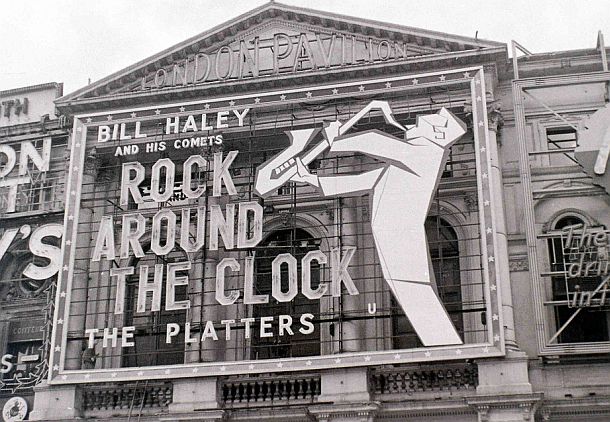
1956: Bill Haley and His Comets receive top billing at the London Pavilion for the film, “Rock Around The Clock,” which produced enthusiastic teen audiences throughout England and beyond – and some rioting as well.
|
U.K. Tours 1957: Feb / March |
British Charts. In 1956, the year before their first visit to England, Haley & The Comets practically dominated the British charts, with as many as five songs appearing in the Top 20. In January, “Rock Around the Clock” was No. 1 on the New Musical Express (NME) Best-Selling Chart. “Rock A Beatin‘ Boogie” was also on that chart that January, followed by “See You Later Alligator” in March, and “Saints Rock `n Roll” in May. The film, Rock Around The Clock came out in England in August 1956, which helped put more Haley tunes on the Hit Parade – “Rocking Through the Rye” and “Razzle Dazzle” – giving them the distinction of landing five separate hits that fall in the British Top 20Twenty. In November, “Rip it Up” and “Rudy’s Rock” hit the charts. In England at that time, Haley and the Comets were guaranteed advance sales of 100,000 copies on every recording released there.
Sullivan Show & Bandstand. Back in the States later that year, Haley and band made their second appearance on the Ed Sullivan Show on Sunday, April 28, 1957 performing the songs “Rudy’s Rock” and “Forty Cups of Coffee.” They also appeared on Dick Clark’s American Bandstand ( ABC-TV) in 1957, once on the prime time show, October 28th, 1957, and once on the regular daytime show, November 27th, 1957. There were also two later appearances on Dick Clark’s Saturday Night Beechnut Show, a primetime show – on March 22, 1958, during the first season, and February 20th, 1960, performing three songs: “Rock Around the Clock,” “Shake, Rattle, and Roll,” and “Tamiami.” Haley had also appeared on Bandstand before Dick Clark was the DJ – in 1953, when it was known as just “Bandstand” and the DJ was Bob Horn.
 November 1958: Some of the fans at Strasbourg, France who came out to rave and dance to the rock `n roll music of Bill Haley and His Comets during their European tour. |
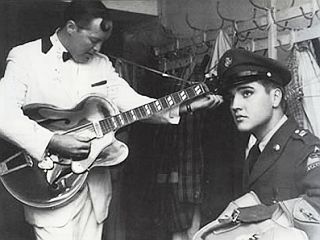 Bill Haley and Elvis Presley meeting backstage in Stuttgart, Germany in Oct 1958. Presley was stationed in Germany. |
More Touring
Bill Haley and band continued touring in both the U.S. and abroad during 1957 and 1958, also cutting new recordings. In the spring of 1958, April and May, they toured the South American countries of Brazil, Argentina and Uruguay with dates in Buenos Aires, Montevideo, and Rio de Janeiro. The South American tour took place at a time when Haley’s last hit on the U.S. charts, “Skinny Minnie.” Facing some financial difficulty due in part to poor management, lavish spending, and not getting the hits they had earlier, Haley and The Comets undertook a tour in late 1958 of mainland Europe that was designed in part to help make a financial recovery.
In early October 1958 they began in Italy, playing a few dates there until the Pope died, causing the rest of their Italian dates to be cancelled. Then in Spain, after one performance before 3,000, where some of the crowd got out of hand, their music was outlawed and concerts cancelled. In France some shows were curtailed. In Germany they were well received, but had trouble in two cities, Berlin and Essen, where riots broke out. In Stuttgart, Germany, Haley and Elvis Presley had some impromptu meetings. Presley, who had been drafted into the U.S. Army, was then stationed in Germany, and he visited with Haley backstage at one show date.
During the early 1960s, in the fall of 1962, Haley and the Comets also had a successful stint at the Star Club in Hamburg, Germany, where they played around the time the Beatles were there as the house band in their early years. According to one of the Comets, Al Rappa, they had met the Beatles in Germany and were friendly with the group.
Mexico & The Twist
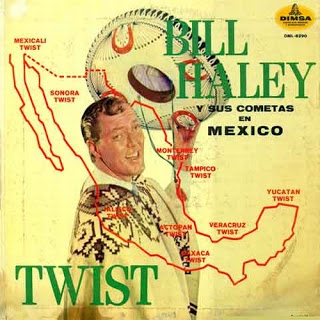
1960s: Bill Haley and Comets featured on a Dimsa album cover for one of their Mexican “twist” recordings. Click for CD set.
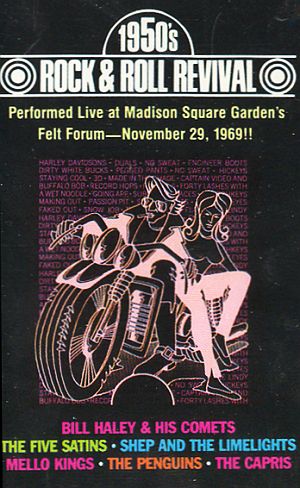
1969: Poster for one of Richard Nader’s “Rock & Roll Revival” shows at Madison Square Garden with Bill Haley & His Comets. Click for related 16pp booklet.
Rock Revivals
In the late 1960s, Haley had a bit of comeback and touring success with a series of rock `n roll revival shows, including dates in the U.S. and Europe. Haley and band played The Royal Albert Hall in London in May 1968. Also that year in Sweden, Haley was contacted by Sonet Records and signed a contract with them, later releasing a number of albums and singles on the Sonet label – songs that never charted in the U.S., though some were hits in other countries. Sonet recorded a new version of “Rock Around the Clock” in 1968, which again hit the European charts.
Back in the States, rock promoter Richard Nader had booked Haley for a series of 1950’s rock `n roll revival shows at New York’s Madison Square Garden. At one of these, on October 18th, 1969, when Bill Haley stepped on stage at the Garden’s Felt Forum, he received an eight-and-a-half minute standing ovation even before he played a single song. A live album, Bill Haley’s Scrapbook, was recorded a few weeks later at New York’s Bitter End club. Haley would appear in at least three of the Nader revival shows into the early 1970s.
By the early 1970s, however, Haley was losing interest in performing. His Mexican wife, Martha Velasco, had given birth to their second child, Pedro, in 1971 (all told, Haley had 10 children in 3 marriages). He and family moved to Vera Cruz, where he bought a boat and an old hotel, and teamed up with some locals there to learn fishing by hand. Still, there was some recording now and then, and other events in U.S. culture also pulled him back into the music scene.
Graffiti & Happy Days
Also helping revive interest in 1950s rock `n roll music – and Bill Haley’s songs in particular – was the 1973 film American Graffiti and the 1974 TV show, Happy Days. American Graffiti was the first film by a new director named George Lucas, who would later go on to Star Wars fame and much more. American Grafitti, released in August 1973, introduced a bevy of future film and TV stars, including: Ron Howard, Richard Dreyfuss, Suzanne Somers and Harrison Ford. It focused on the post-WWII teenage culture of baby boomers – cars, girls and rock `n roll culture of the 1950s essentially – and generated the third highest Hollywood film box office that year. It was also one of the first films to use original rock `n roll music throughout the movie’s soundtrack – with Bill Haley’s “Rock Around The Clock” as the first song on the soundtrack album.
In the year following the film, a new television series, Happy Days, also using a story line from the 1950s-1960s, and starring Ron Howard, Henry Winkler and others, used “Rock Around the Clock” as the opening theme song for the 1974-75 season, helping to boost the Haley song once again. “Rock Around The Clock” was subsequently re-issued on MCA records and peaked at No. 39 on the Billboard singles chart in March 1974. The revived interest in Haley’s music helped give Haley a few more years of touring and playing rock `n roll revival shows. During a 1974 tour of the U.K., Haley was presented with an award in London by singer Olivia Newton John from MCA Records for “Rock Around the Clock’s” distinguished performance on the British charts, having re-entered those charts seven times between 1954 and 1974.
Texas & Final Days
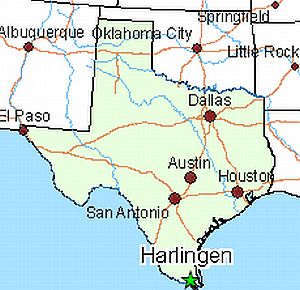
In 1976, Bill Haley & family moved to Harlingen, TX, on the “toe” of Texas, just north of the Mexican border with access to the Gulf of Mexico.
There, the family settled into a more or less normal family life, with Haley declining further press and turning his attention to family and his children’s activities, ball games, and occasional get-togethers with neighbors. During this time, Haley also bought as an investment a trailer park in the area – the Val Verde Trailer Park — once a luxury country club and enclave for America celebrities, with cottages, pool, and other facilities, still used as a winter retreat for Texans when Haley bought it. He became the on-site manager there, hoping to make it pay off.
But Haley by this time had drifted into heavy drinking and erratic behavior. He would sometimes go off on long drives in his Lincoln Continental automobile, returning home drunk or not coming back for days. Between 1976 and 1981 he was arrested four times for DWI and drunkenness.

Nov 1979: Bill Haley greeting Queen Elizabeth II in London after his role in the Royal Variety Performance.
Then in May 1980, Haley set off to tour once again, this time to South Africa for three weeks of shows. But there, according to his wife Martha who traveled with him, he had some bizarre moments on stage, telling stories to his audience rather than singing. Back in Texas, in the fall of 1980, family members noticed more odd behavior, including his son Jack, who had come for a brief visit that proved troubling. Old friends and former business associates were getting rambling, late night phone calls as well. At this point, he appears to have begun living in the pool house, while the family stayed in the main house. In the fall of 1980, Haley was picked up by the police and detained, then bailed out by Martha, who had him see a psychiatrist, who gave him some medication. Some believe Haley may have had an underlying anxiety disorder, leading to a chemical imbalance in the brain, with Haley then self-medicating with alcohol. In any case, there were more episodes of Haley’s odd behavior, some paranoia, and becoming almost a Jekyll-and-Hyde type character. There had also been news reports of Haley having a brain tumor, but these appear to have been fabrications, or false stories used to keep him from further touring.
Sad Ending
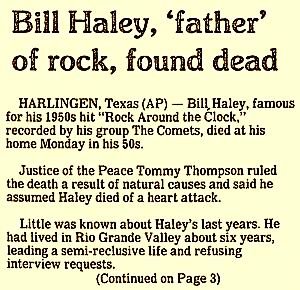
February 10th 1981: AP story appearing in some American newspapers, here from the front page of ‘The Spokesman-Review,’ Spokane, WA.
In the end, Bill Haley at the time of his death was an unheralded music pioneer overlooked and neglected for his contributions to the rise of rock `n roll. And Bill Haley clearly felt that neglect while he was alive – especially in his later years. He had been overshadowed by Elvis, and he felt that keenly too. In some ways, no doubt, the lack of recognition contributed to his sad ending, breaking his spirit. True, Haley had his demons and insecurities, not least was his life-long impaired vision in one eye. Others suggest that he may not have had the personality for the life he chose and was just not a good fit for the high-exposure world of pop music celebrity. His bandmates and others noticed that he wasn’t always comfortable in the role of rock star, sometimes retreating to his room when on the road. He wasn’t always the “party animal” type, and had acknowledged on several occasions a preference for family and spending time at home. Still, he met his celebrity obligations in good form; he performed thousands of times and engaged with the press and public the best he could. In the end, Bill Haley was a musician, with an irresistible itch to scratch – to record, to write, to create something new. Which he did in some profusion.
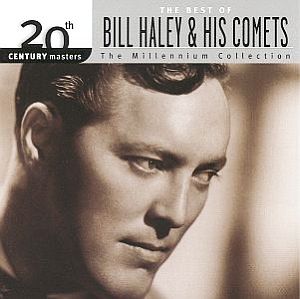
Album cover, “The Best of Bill Haley & His Comets,” in the 20 Century Masters series, MCA Records, 1999. Click for CD.
Still, as it turned out, he was mostly forgotten and overlooked – at least at the time of his death and for some years thereafter. In 1986, when the Rock and Roll Hall of Fame named 16 individuals to be inducted into its first class of honorees, Bill Haley was not among them. In that first year of inductions, Elvis Presley, Little Richard, Chuck Berry, James Brown, the Everly Brothers, Fats Domino, Jerry Lee Lewis and Buddy Holly were among those included, but not Bill Haley. However, he was posthumously inducted in 1987.
Bill Haley and His Comets had 37 hit records. Overall, Haley & Co. figure into more than 400 titles that were recorded and released over a period of forty years. Haley also recorded over a hundred titles on at least four different Latin American labels. At the time of his death, Bill Haley had sold an estimated 60 million records – half of which, by some counts, were “Rock Around The Clock.”Since Bill Haley’s death in 1981 there have been several books written about him, including one co-authored by his first son John “Jack” W. Haley and John von Hoelle, titled, Sound and Glory, published in 1990. To mark the 30th anniversary of Haley’s death in 2011, a mammoth tribute volume by Otto Fuchs, an Austrian Bill Haley fan, was published. First issued as an earlier German-language edition, Fuchs’ Bill Haley: Father of Rock ‘n’ Roll, runs 900 pages or more, depending on edition. The most recent edition has been revised and updated, incorporating a number of many interviews, some with former Comet band members. There is also Jim Dawson’s book, Rock Around the Clock, published in July 2005 at the 50th anniversary of Haley’s song, ‘Rock Around the Clock.’ Haley’s music, meanwhile, has been issued in new compilations, including obscure session cuts and others that only die-hard fans may appreciate. In 1999, Bear Family Records released two boxed sets covering his career from 1954 through 1969, and Roller Coaster Records issued Haley’s Essex recordings from 1951-54 material in 1995.
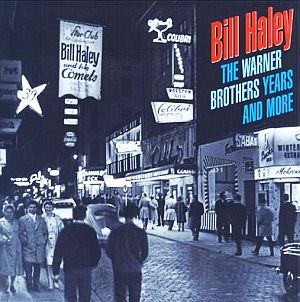
Cover of 6-CD set of Bill Haley’s music issued by Bear Family Records in 1999, also showing street scene and club banner from the Star Club in Hamburg, Germany when Haley & The Comets appeared there in 1962. Click for CD set.
Haley’s Legacy
In his performing years, Bill Haley was often humble about his contribution to the emergence of rock `n roll, and was quick to offer perspective about the times and his music. “People associate the beginning of rock ‘n roll with 1954,” Haley once said. “Actually, it had been gathering momentum and when we made ‘Rock Around the Clock’ it just exploded. . . . That’s when the mob scene started — thousands of kids at the stage door . . . It wasn’t because we were so great. The hysteria wasn’t for us. It was for the music. This was a new music for kids who hadn’t had any of their own…” True enough – to a point.
Yet musicians like Haley clearly helped craft a new sound. Some regard Haley as among the key musical alchemists of that era who blended bits and pieces of other musical genres to come up with something new. Though in Haley’s case, he did make some singular contributions, as Bob Stanley observed in The Guardian of London in May 2014:
“…No one had blended country and R&B on a single before the Comets’ ‘Rock the Joint’ in 1952. No one had scored an American Top 20 hit with anything that could really qualify as rock`n roll before their single ‘Crazy Man Crazy’ in 1953. And ‘Rock Around the Clock’s’ international success in 1955 …opened the door for modern pop.”
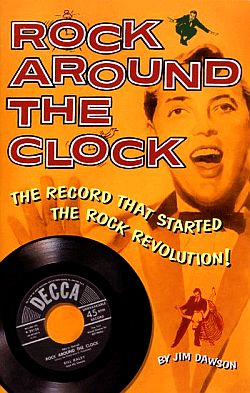
Cover of Jim Dawson's 2005 book, ‘Rock Around the Clock: The Record That Started the Rock Revolution,” published at the 50th anniversary of ‘Rock Around the Clock’ hitting No. 1 on the Billboard charts. Click for book.
“…Haley and his hard-charging crew understood the music well enough to execute it respectfully, right down to the careening solos and whomping stop-time breaks. Some credit for this goes to producer [Milt] Gabler, who… communicated to the Comets the fine points of the danceable backbeat. They obviously learned quickly, burning this high-spirited jump blues – recorded before Elvis Presley ever registered a chart hit – into the very source code of rock and roll.”
Along with the early bluesmen like Robert Johnson and anonymous R&B artists who were laying the groundwork for rock `n roll in the 1940s and earlier, as well as those who took it forward the 1950s – including Big Joe Turner, Ike Turner, Fats Domino, Elvis Presley, Jerry Lee Lewis, and others – Bill Haley is rightfully there beside them in that pantheon of rock `n roll founders, where he should have been all along.
Additional stories at this website on the history of popular music, its artists, and the music industry can be found at the “Annals of Music” category page. Postings for stories at the PopHistoryDig can also be found at Twitter and Facebook. Thanks for visiting – and if you like what you find here, please make a donation to help support the research and writing at this website. Thank you. –Jack Doyle
|
Please Support Thank You |
____________________________________
Date Posted: 17 March 2016
Last Update: 9 November 2022
Comments to: jdoyle@pophistorydig.com
Article Citation:
Jack Doyle, “Rock Around The Clock – Bill Haley:
1951-1981,” PopHistoryDig.com, March 17, 2016.
____________________________________
Sources, Links & Additional Information
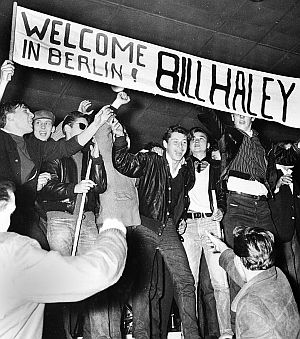 Oct 1958: Bill Haley & Comets being welcomed to Berlin, Germany by a throng of happy fans. AP photo. |
 Bill Haley and Big Joe Turner in performance together during a 1966 episode of the Mexican TV show, “Orfeón a Go-Go.” |
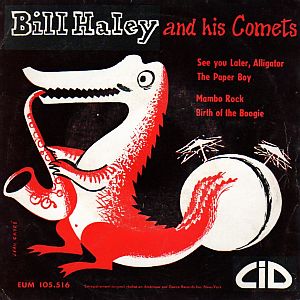 Record jacket cover for Bill Haley’s “See You Later Alligator” & 3 others on the CID label, France, 1957. |
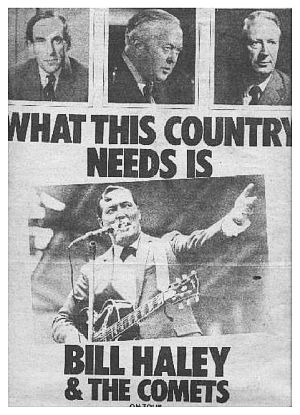 This poster – “What This Country Needs Is... Bill Haley & The Comets” – appeared in the UK music press in Feb 1974 as Haley & the Comets were on tour there. The politicians shown at the top of the bill were: Jeremy Thorpe (Liberal), Harold Wilson (Labour) and Edward Heath (Conservative). |
“Bill Haley,” in Holly George-Warren and Patricia Romanowski (eds), The Rolling Stone Encyclopedia of Rock & Roll, Rolling Stone Press, New York, 3rd Edition, 2001, p. 403.
Hank Bordowitz, Turning Points in Rock and Roll, Citadel Press,2004.
“Bill Haley,” Wikipedia.org.
“Bill Haley and His Comets,” Wikipedia.org.
Bosley Crowther, “The Screen; ‘Blackboard Jungle’; Delinquency Shown in Powerful Film”
New York Times, March 21, 1955.
United Press, “‘Blackboard Jungle’ Banned,” New York Times, April 13, 1955.
Mae Tinee, “Shocking Tale in ‘Blackboard Jungle’ Movie,” Chicago Daily Tribune, May 4, 1955, pt. 3, p. 4-F.
“‘Blackboard Jungle’ Heads Week’s Movie Offerings,” The Victoria Advocate (Victoria, TX), May 8, 1955, p. 2-A.
“Blackboard Jungle,” Wikipedia.org.
Bruce Eder, Rovi, “Bill Haley, Biography,” Billboard.com.
“Bill Haley, Timeline,” Rock and Roll Hall of Fame.
“Princeton Suspends 4; Action Is Aftermath to Rioting Earlier in Week,” New York Times, May 21, 1955.
“Segregationists Would Ban All Rock, Roll Hits,” Billboard, April 7, 1956
“White Council vs. Rock and Roll,” Time, April 18,1956.
“Rock and Roll Fever,” St. Louis Post-Dispatch, June 13, 1956.
“New Jersey Bans Bill Haley,” Time, July 23, 1956.
Thomas P. Ronan, “British Rattled by Rock ‘N’ Roll; Youths Go Wild in Theaters, Jive and Sing in the Streets and Attack Policemen…No Stir in New York; Berlin Having Its Troubles,” New York Times, September 12, 1956.
“Don’t Knock the Rock,” Wikipedia.org.
Joseph R. Marshall, “Rock Around The World,” St. Petersburg Times, October 14, 1956, p. 10-E.
“The Biggest Rock n Roll Show of 1956,” A Rock`n Roll Historian, February 1, 2016.
Chris Gardner’s Bill Haley Gallery, 1955-1958.
This Day in History: February 5, 1957, “The American Invasion Begins, As Bill Haley and The Comets Storm Britain,” History.com, Accessed, March 1, 2016.
“Roll, Britannia!,” Time, Monday, February 25, 1957.
“Bill Haley & His Coments,” European Tour Booklet, Presented by Lew & Leslie Grade, By Arrangement With The Rank Organization, February 1957.
Otto Fuchs, Bill Haley: Father of Rock `n Roll, Wagner, 2014.
“Bill Haley: The Father of Rock & Roll,” RockaBillyHall.com (webpage on Otto Fuchs book).
“Rock Around the Clock,” Wikipedia.org.
Michael Lydon, “Wild Bill Haley,” Rolling Stone, November 1967.
“Oldies and Revival Shows Fill A Void for ‘Rough, Direct Music,” Billboard, July 22, 1972, p. 52.
“Richard Nader’s Rock & Roll Revival Celebrates 5th Year,” Billboard, October 19, 1974.
Martin Hawkins, “Bill Haley: The Guardian Of Rock ‘N’ Roll,” Melody Maker, April 1979.
Martin Weil, “Bill Haley Dies, Classic Was ‘Rock Around Clock’,” Washington Post, February 10, 1981.
Robert Palmer, “Bill Haley, 55, Dies; Singer-Band Leader,” New York Times, February 10, 1981.
Associated Press, “Bill Haley, ‘Father’ Of Rock, Found Dead,” The Spokesman-Review (Spokane, Washington), February 10, 1981, p. 1.
John Swenson, Bill Haley, London: W.H. Allen, 1982, 174pp.
“Entertainment by the Numbers: 10 Greatest Jukebox Hits of All Time,” Los Angeles Times, March 12, 1990.
John W. Haley (Haley’s eldest son), with John W. von Hoëlle, Sound and Glory, Wilming-ton, DE: Dyne-American, 1990.
Robert Hilburn, “Rock ‘n’ Roll Films Set Market on Fire,” Los Angeles Times, March 31, 1991.
Linda Martin, Kerry Segrave, Anti-Rock: The Opposition to Rock ‘n’ Roll, Da Capo Press, 1993, 374pp.
Jim Dawson, Rock Around the Clock: The Record That Started the Rock Revolution!, San Francisco: Backbeat Books, 2005.
Steven R Rosen, “Book Review of Jim Dawson’s Rock Around the Clock: The Record That Started the Rock Revolution,” Denver Post, June 2005.
Michael Hall, “Falling Comet,” Texas Month-ly, June 2011.
“Bill Haley and His Comets ‘Rock Around the Clock’ in Strasbourg, France, 1958,” Stars and Stripes, April 22, 2014.
Margaret Moser, “When the Clock Strikes 12: Bill Haley, the Father of Rock & Roll?,” Austin Chronicle, May 16, 2014.
Bob Stanley, “Bill Haley: Rock Around the Clock – The World’s First Rock Anthem,” The Guardian.com, May 22, 2014.
“Songwriter Struck Gold as the Clock Struck Twelve O’ Rock” (obituary for James Meyer, co-author, “Rock Around The Clock”), The Times (undated).
Alex Frazer-Harrison, “Reviews and News About Bill Haley and The Comets,” Rocka-BillyHall.com.
Todd Leopold, “The 50-Year-Old Song That Started it All; ‘Rock Around the Clock’ Made Bill Haley the First Rock Star,” CNN.com, July 8, 2005.
Martin Chilton, “Rock Around the Clock: How Bill Haley’s Song Became a Hit,” The Telegraph (London), February 9, 2016.
“Bill Haley, 1925-1981,” BillHaley.co.UK.
____________________________
